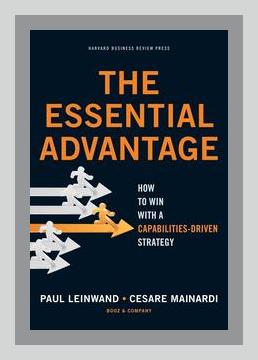Business StrategyStrategic Planning
Introduction
“The Essential Advantage: How to Win with a Capabilities-Driven Strategy” delves into the concept of leveraging unique capabilities to create and sustain competitive advantage in the business world. Authors Paul Leinwand and Cesare Mainardi illustrate their thesis through a strategic framework that helps companies identify and capitalize on their core strengths. The book’s insights stem from extensive research and decades of consulting experience with Booz & Company (now Strategy&). It is organized around several key themes and supported by numerous real-world examples, offering actionable strategies for businesses aiming to differentiate themselves in a crowded market.
1. Understanding Capabilities-Driven Strategy
Major Points:
- Definition and Importance: The book introduces the concept of a capabilities-driven strategy as the alignment of a company’s distinct abilities with its market positioning and value proposition.
- Core Capabilities: These are the unique strengths that a company develops over time, which drive its success more effectively than imitating competitors.
Action Steps:
- Identify Core Capabilities: Conduct an internal audit to list all possible capabilities your company has, then shortlist the ones that have consistently driven past successes.
- Focus on Unique Strengths: Restructure organizational goals to prioritize and bolster these core capabilities rather than spreading resources thin.
Example: The authors cite Apple’s ability to integrate hardware and software as a core capability that allows it to innovate consistently, setting it apart from competitors.
2. Connecting Capabilities to Market Position
Major Points:
- Strategic Coherence: Aligning capabilities with market needs creates a coherent strategy that guides decision-making and resource allocation.
- Three Levels of Coherence:
- Outside-In: Start with market opportunities and align capabilities accordingly.
- Inside-Out: Understand existing capabilities and find markets where they can be fully leveraged.
- Balanced: Combine internal strengths with external demands for balanced growth.
Action Steps:
- Market Analysis: Perform a thorough market analysis to determine where your capabilities can deliver the most value.
- Strategy Realignment: Regularly review and realign your market position to ensure it remains closely tied to your core capabilities.
Example: IKEA’s strategy aligns its capability in affordable, stylish furniture design with its market positioning by centralizing design and production, ensuring operational efficiency.
3. Building and Nurturing Capabilities
Major Points:
- Capability Development: Create robust systems for developing and nurturing key capabilities within the organization.
- Invest in Talent Management: Ensure continuous improvement through talent development, fostering a culture of learning and innovation.
Action Steps:
- Capability Building Programs: Integrate programs within HR for constant capability enhancement, such as training, mentorship, and R&D investments.
- Collaborative Environment: Foster a culture that encourages collaboration, knowledge sharing, and cross-functional teams.
Example: Procter & Gamble (P&G) has built a robust capability in consumer understanding and brand management through continuous investment in market research and employee training.
4. Developing a Capabilities System
Major Points:
- Systematic Coherence: Develop a system where all capabilities work in synergy rather than in isolation.
- Establishing Feedback Loops: Implement feedback mechanisms to continually refine and optimize these systems.
Action Steps:
- Integrate Processes: Develop integrated processes that ensure coherence across various departments. Implement enterprise resource planning (ERP) systems to streamline operations.
- Feedback and Adjustments: Regularly solicit feedback and make necessary adjustments to ensure all parts of the system are working harmoniously.
Example: Toyota’s renowned production system, also known as “The Toyota Way,” exemplifies systematic coherence where practices such as just-in-time production and quality management are interlinked to support continuous improvement.
5. Leadership and Organizational Structure
Major Points:
- Adapting Leadership: Leadership styles and organizational structures must evolve to support a capabilities-driven strategy.
- Flexible and Responsive: An adaptable leadership approach ensures rapid responses to market changes without compromising core capabilities.
Action Steps:
- Leadership Development: Implement leadership training programs that focus on strategic capabilities development.
- Organizational Design: Design organizational structures that are flexible and encourage autonomy while maintaining strategic alignment.
Example: IBM transitioned from a product-oriented to a service-oriented strategy, reflecting a shift in leadership and organizational design to enhance its capabilities in IT services and consulting.
6. Execution and Ongoing Management
Major Points:
- Operational Execution: Implement consistently, ensuring that strategic coherence is maintained throughout the organization.
- Monitoring Performance: Use key performance indicators (KPIs) that align with capability-driven goals to monitor and manage performance.
Action Steps:
- Performance Metrics: Develop KPIs that specifically measure the efficiency and effectiveness of core capabilities.
- Regular Reviews: Conduct regular performance reviews and strategy refinement sessions to ensure continuous alignment with market demands.
Example: Starbucks maintains its market position through consistent execution of its capabilities in customer experience and operational efficiency, regularly reviewing performance metrics to stay aligned with its strategic goals.
Conclusion
“The Essential Advantage” provides a comprehensive guide for businesses to build, leverage, and sustain competitive advantage through a capabilities-driven strategy. By understanding and nurturing their unique strengths, aligning them with market needs, and ensuring organizational coherence, companies can navigate complex markets effectively. The numerous real-world examples and actionable steps offer practical insights for leaders seeking to apply these principles within their organizations.
Key Takeaways:
- Identify Core Capabilities: Discover what unique strengths your company possesses and how they have driven success.
- Align with Market Needs: Ensure your capabilities and market position are coherent and complement each other.
- Invest in Development: Continuously develop and enhance these capabilities through talent management and innovation.
- Systems and Coherence: Integrate capabilities into a coherent system where they support and reinforce each other.
- Adaptive Leadership: Employ a flexible leadership approach that supports capability development and strategic execution.
- Consistent Execution: Implement strategies systematically and monitor performance to ensure continuous alignment and improvement.
By following these guidelines, organizations can carve out a sustained competitive advantage that stands the test of time and market dynamics.
